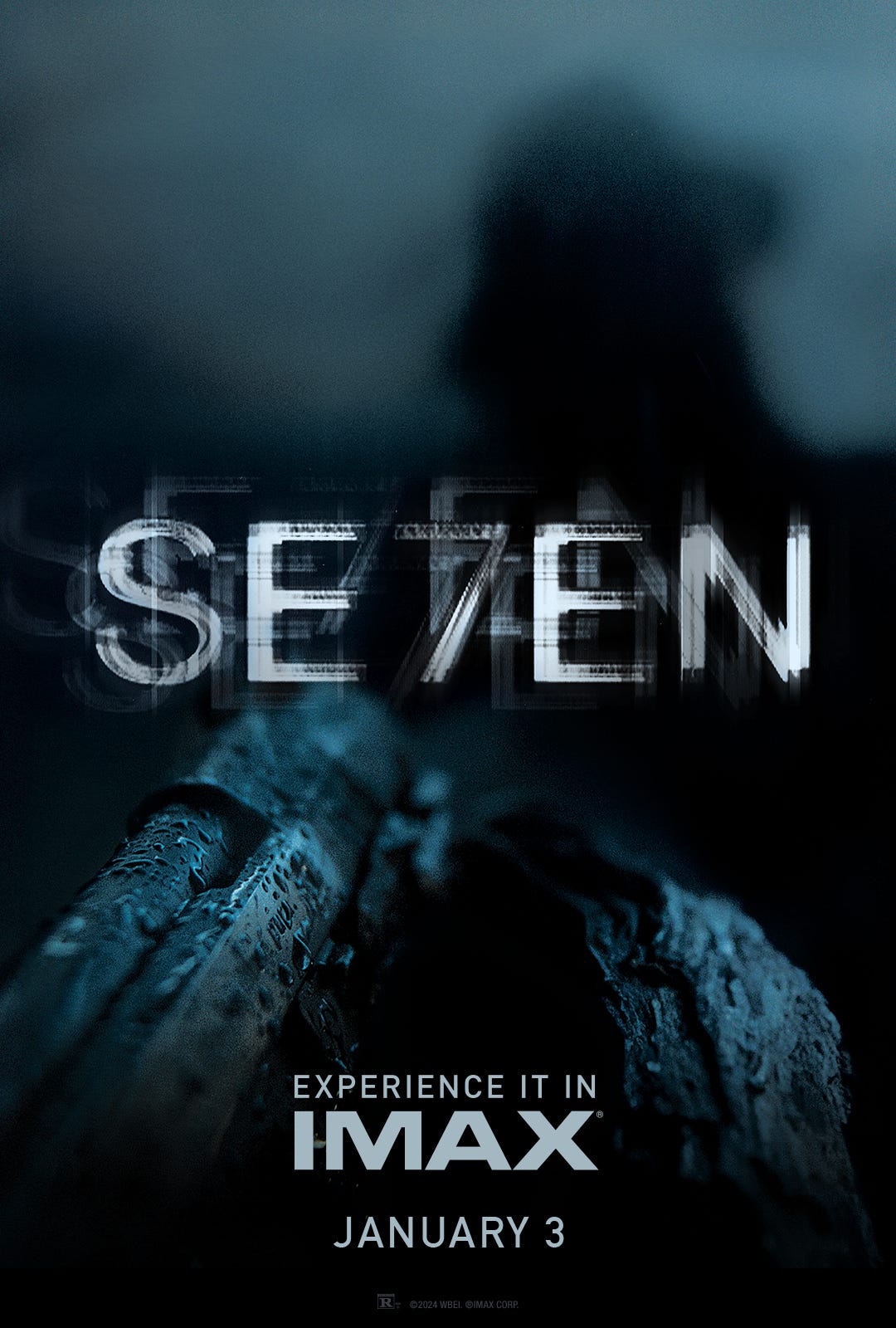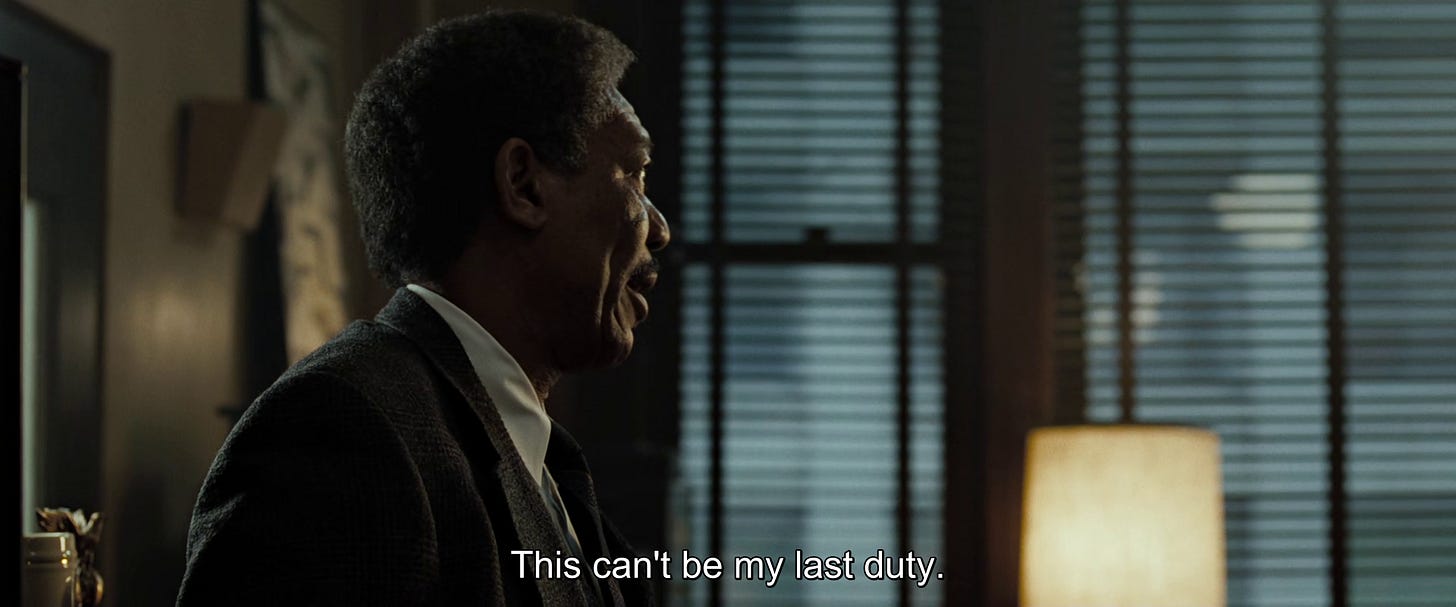Issue #361: The Exacting Gaze of Fincher's Seven (1995)
Last week was a big one for the newsletter. Our first ever movie marathon event was a huge success. Thanks to all those who attended. All the movies were great, very different in what they offered. Daimajin (1966) was a great opener to the marathon, as it is the film among the three that most rewards close attention. I can imagine it served to influence Princess Mononoke (1997) and touched on some of the same themes, funnily enough, as Nosferatu (2024).
Daimajin is part of a much larger tapestry of Japanese eco-criticism. Like Nosferatu, it also critiques enlightenment thinking, suggesting that the horizon of scientific knowledge will always be limited by the technological capability of one’s epoch.
The film doesn’t offer just kaiju action, but samurai sword battles that rival some of the most admired chanbara cinema.
The War of the Gargantuas (1966) may have been the low point of the marathon, but it was still a lot of fun. Russ Tamblyn is, very confusingly, the star. There’s a lot of collaboration among the people of Tokyo to prevent the monster’s attacks. With the use of bizarre sci-fi weapons filmed as miniatures, the Neon Genesis Evangelion (1995) episode "Decisive Battle in Tokyo-3" seems to have been hugely influenced by Gargantuas.
Daigoro vs. Goliath (1972) was both ridiculous and spectacular. It delivers lots of laughs. All three are very much worth watching.
I’m planning on doing one of these again soon, so keep an eye on the letter and consider a paid subscription if you would like to join our Discord server. It’s been a nice little addition I think, especially for facilitating the movie streaming. If you are a current paid subscriber having any issue getting into the server, let me know.
2024 Gaming Recap
Among all mediums of entertainment I enjoy, video games may have had the strongest 2024. I don’t get to play video games as much as I would like to, but I certainly had some periods of high volume gaming and got to sample a wide variety of games. I only finished a few: Alan Wake 2 (2023), Like a Dragon: Infinite Wealth (2024), Final Fantasy VII Rebirth (2024), and The Legend of Heroes: Trails into Reverie (2020). Without a doubt, Like a Dragon is the best game I played this year. But I also thoroughly enjoyed Romancing SaGa 2: Revenge of the Seven (2024), Trails Through Daybreak (2024), Dragon Quest III HD-2D Remake (2024), Eiyuden Chronicle: Hundred Heroes (2024), and FANTASIAN Neo Dimension (2024). I’m sure I’ll finish at least two of these during 2025.
Along with those, I played some interminable live service games like Super Snail (2023) and Zenless Zone Zero (2024). Super Snail has maintained my daily attention since launch.
But I wanted to mention briefly a few games I enjoyed toward the end of the year that had some unique design quirks.
Dragon’s Dogma II (2024)
Despite loving this game at first, I hit about twenty hours of playtime and felt unsure I was going to continue. Combat is fun, the relationship with the NPCs is inventive, the quests are varied and challenging. But Dragon’s Dogma II also limits fast travel in some bizarre ways: either through consumable (and somewhat precious) ferrystones or unwieldy oxcarts. Ferrystones work more or less how you would expect, taking you from anywhere to some specific destinations called portcrystals in the game. Most are dictated by the game itself, but you’ll get some portcrystals you can place. The oxcarts are more limited. They only travel specific routes at specific times, cost money, and are regularly interrupted by attacks of beasts or brigands.
All of this is done for the sake of immersion. And it’s a neat trick. The first time you ride an oxcart, you might not even press the button to “doze off” and watch the scenery go by. The first time you are attacked on an oxcart, it’s a thrill. And being required to traverse the to and from your destination on foot has its perks. There are fun things to explore and unexpected encounters that could come up. But there aren’t too many. If my experience is any indication, this all wears thin by hour twenty. I can’t really stomach another long walk from wherever to wherever.
Balatro (2024)
Balatro is one of those photo finish games I only barely played in 2024. Despite being inordinately hyped, I didn’t pick it up until December 30th. I’ve been playing it a good bit since, though. It is a great game for all the reasons everyone says it is.
What I appreciate most about Balatro at this stage is the unique gameplay dictated by each build. You can add cards to your deck, get powerful Jokers that might impact every hand you play, use Tarot cards for temporary advantage, and use other methods to gain advantages and buffs. Depending on the buffs you have available, you will play very differently. That is unique in contrast to some other roguelikes that have unique builds but not unique gameplay. Compared to Vampire Survivors (2021), for instance, you will certainly make different choices selecting weapons and passive items depending on which build you are trying to achieve. But the actual gameplay itself doesn’t change much. In Balatro, every decision is dictated by your build — both because of what buffs you might have at a given time and which ones you might want to target in the future.
Erin is also hooked on it. I think we’ll be battling to see who has more playtime by the end of 2025.
Seven on the Big Screen
I saw Seven (1995) in its limited IMAX engagement over the weekend. This is something I would have posted about in the newsletter in advance, but I didn’t realize it was even happening until Friday, when the screenings started.
I’m a big fan of Fincher, as one might expect. I have found his work to be relaxing despite the subject matter. Seven, The Game (1997), Zodiac (2007), Mindhunter (2017), and The Killer (2023) especially. I have rewatched all of them a lot. I used to watch Mindhunter while grading. Seven has so much rain that at the right moment you might confuse it for the soothing sounds of recorded weather for a noise machine. Reg E. Cathey’s delivery of the line “he’s got lines of distention across the duodenum” is more instantly recognizable to me than Brad Pitt screaming “what’s in the box?”
This could just be a personal quirk, but I’m convinced Fincher’s direction has a lot to do with the feeling of calm his work can inspire despite their brutal and punishing moments. His films are regimented. He directs his actors within an inch of their lives. He has the same attention to detail as Hitchcock, something he recognizes in his tribute to Hitch in Panic Room (2002), making him a “director’s director.” But he certainly doesn’t direct for the performer, who is subjected to anywhere between twenty five and two hundred takes when filming any given scene. There is no question this changes the performances. One doesn’t know which take made it to the final cut, but the rhythmic repetition of each line read is something I feel while watching regardless of whether I am seeing take one or take two hundred.
Fincher’s gaze is clinical. He favors the restraint of Detective Somerset (Morgan Freeman) in his filmmaking, where emotional exegesis is a climactic moment or exposure of a tragic fault. Seven is, perhaps, the most clinical and alien of his films. Somerset and Mills (Brad Pitt) walk through scenes inspired by The Inferno (1321) and investigate them like they’re your average home invasion. The only point where Somerset truly expresses that something might be amiss is in his plea to be taken off the case — and “plea” is a strong word.
If I had to guess, I’ve seen Seven in part at least ten times and front to back maybe five. On the big screen, it was like watching it again for the first time. The sounds (the rain, the description of the duodenum) were mostly familiar. But the weight of the film bearing down on me was something completely different. It is a mean-spirited film, punishing to its audience. Instead of being a relaxing experience, I spent half the film feeling like I was in fight-or-flight mode — something pretty uncommon for me when watching a movie, although I recently experienced this same sense watching Red Rooms (2024).
Despite a serial killing being the obvious perpetrator to Somerset, such a category of criminal represents a disruption of normalcy. But what Seven suggests is that the abnormal, deviant, and incoherent are the constituent parts of the immoral and repugnant city. Somerset continues to caution Mills about the “here” of the film, “this city” which is never precisely identified in the film.




Thus, even as the normal is disrupted, Somerset proceeds methodologically. His approach, disconnected from the need for justice, is routine, “picking up diamonds on a deserted island.”


He is logical to the last, even confronting John Doe (Kevin Spacey) with the contradiction of his murderous sermon:
If you were chosen, that is, by a higher power, and if your hand was forced, it seems strange to me that you’d get such enjoyment out of it. You enjoyed torturing those people. This doesn’t seem in keeping with martyrdom, does it?
Doe seems legitimately disquieted by Somerset’s use of logic. But no amount of logic can cover over the enjoyment circulating among Somerset, Doe, and Mills. Doe is right that he and Mills are two sides of the same coin. But the question is whether or not Somerset has truly given up on the “rush” of apprehending criminals or if he is every bit the investigative machine he presents himself as. Such a machine is ill-suited to the inconsistencies and absurdities of the city. But Somerset’s approach locates John Doe, with the help of yet another categorizing apparatus — the FBI logging everyone’s library books.
This brings me back to Fincher. Seven is so meticulous, as are all his films. That relentless pursuit of exacting perfection is bound to convey a lot to its audience. But it also takes more than repetition and manifesting a vision to make a great film. The vision itself must also be great. And that strength of Fincher’s is even more important than how he makes films. As a parallel, Somerset’s approach to investigation matters a lot, but less than Somerset being himself.
Filmmaking is not always an art form that one person can control. One hears that resignation in Somerset’s final spoken lines, “Around. I’ll be around,” themselves a revision of the conclusion to Chinatown (1974), “forget it, Jake. It’s Chinatown.” As much control as one exercises over a film, they will never be able to control how the audience responds to it. Recognizing that is what makes Fincher great. He can make what’s on the screen his version of perfection, but the audience will take it as they will.
Weekly Reading List
Some special music to begin your year.
AGDQ is on right now. https://www.twitch.tv/gamesdonequick
I’ve been re-reading Critique of Pure Reason (1781) in the Pluhar translation from Hackett and have been blown away. It is so, so much better than what I have read in the past. I highly recommend it, even over the Guyer/Wood translation from Cambridge (which I have also been periodically consulting). But to be honest, I think I first read it in translation from Norman Kemp Smith… not recommended.
Until next time.








